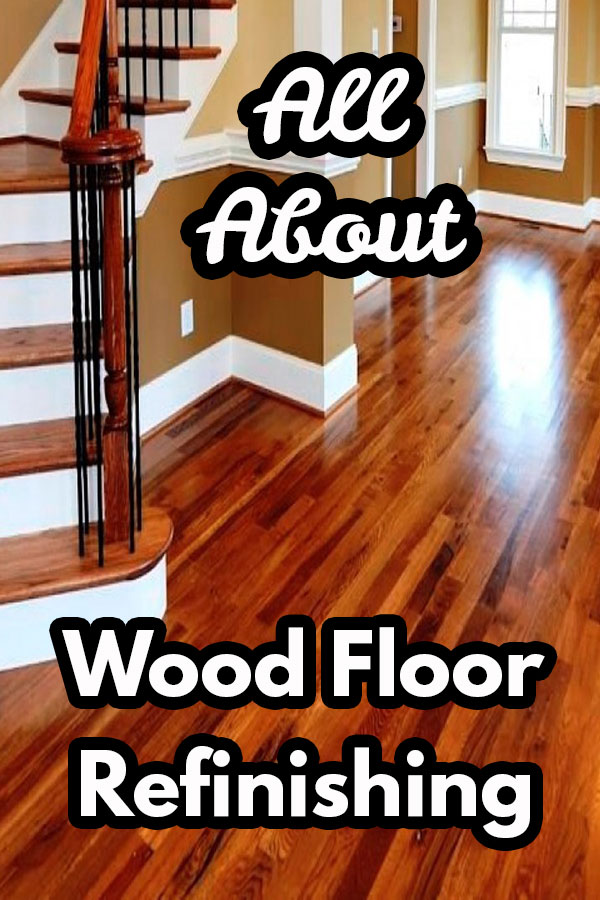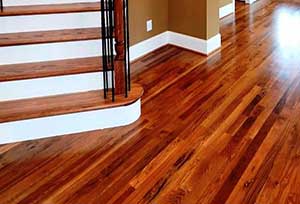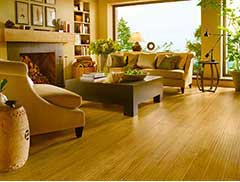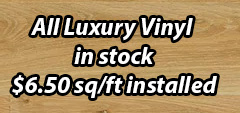 Wood floor refinishing is one of the most relatively inexpensive ways to greatly improve the look of your home. It makes your floors look new again and you can even change the color & sheen. It can be 3-5 times less costly than replacing the floor. The process of sanding & refinishing hardwood involves sanding down the floor with a sanding machine until the polyurethane & stain coat are removed & raw wood is exposed. The floor is then stained any desired color or left natural and 2-3 coats of polyurethane are applied. Wood floors are refinished about every 10 years. Hardwood floors can be refinished several times or until sanded down to the tongue & groove.
Wood floor refinishing is one of the most relatively inexpensive ways to greatly improve the look of your home. It makes your floors look new again and you can even change the color & sheen. It can be 3-5 times less costly than replacing the floor. The process of sanding & refinishing hardwood involves sanding down the floor with a sanding machine until the polyurethane & stain coat are removed & raw wood is exposed. The floor is then stained any desired color or left natural and 2-3 coats of polyurethane are applied. Wood floors are refinished about every 10 years. Hardwood floors can be refinished several times or until sanded down to the tongue & groove.
There are basically two types of refinishing jobs – 1. screening 2. sanding & refinishing
Screening
Screening is the quickest & most inexpensive way to refresh your floors but screening is only helpful when your floor simply has scratches on the topcoat. Screening means that only the top polyurethane layer is buffed down with a buffing machine & mesh screen to remove scratches . The floor is then vacuumed & wiped down to remove dust. One or two coats of polyurethane is then applied to the surface. The wood isn’t sanded at all, which is why it’s sometimes called ‘sandless refinishing’.
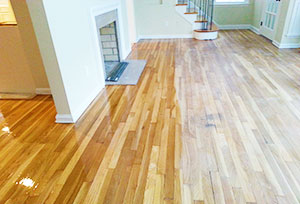 When your wood floor has scratches into the wood, dents, stains, fading, discoloration or water damage then it needs a complete sanding & refinishing. Most floors by 10 years will need the full sanding & refinishing. However if screening is done every few years it can help prolong the need for sanding & refinishing and extend the life of the floors.
When your wood floor has scratches into the wood, dents, stains, fading, discoloration or water damage then it needs a complete sanding & refinishing. Most floors by 10 years will need the full sanding & refinishing. However if screening is done every few years it can help prolong the need for sanding & refinishing and extend the life of the floors.
Also if you want to change the stain color of the floors then it requires sanding & refinishing because screening only removes & replaces polyurethane. Screening though does allow you to change the sheen level (amount of shine) as polyurethane is available in gloss, semi-gloss, satin & matte. Screening is especially recommended for floors with custom design work which can be costly & time consuming to sand & refinish.
A screening job can be completed & walked on all in the same day if water based polyurethane is used. Though it is recommended to wait 3 days after the last finish coat is applied before replacing furniture.
Screening is referred to by several different names which can be bit confusing if you’re not familiar: ‘screen & recoat’, ‘buff & coat’, ‘strip & refinish’ & also ‘sandless refinishing’ (not to be confused with ‘dustless sanding & refinishing’ described below).
Sanding & Refinishing
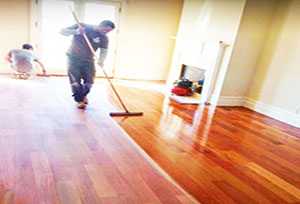 Sanding & refinishing is the most thorough method of renewing wood floors & is more costly than screening. It removes scratches, dents, stains, graying & fading. The finish layer & top layer of wood are sanded down with a sanding machine & pads so that the raw wood is exposed. Sanding is done 3 times, each time with a finer grit pad. This process creates a lot of dust.
Sanding & refinishing is the most thorough method of renewing wood floors & is more costly than screening. It removes scratches, dents, stains, graying & fading. The finish layer & top layer of wood are sanded down with a sanding machine & pads so that the raw wood is exposed. Sanding is done 3 times, each time with a finer grit pad. This process creates a lot of dust.
Dustless sanding & refinishing refers to sanding done with a vacuum equipped “dustless” sanding machine. The built in vacuum reduces most of the dust, though some dust will remain & dusting of the room will be required. Once the polyurethane & top layer of wood are removed, then the floor is stained any chosen color & 2-3 coats of polyurethane are applied. The floor is buffed, vacuumed & wiped between polyurethane coats for stronger adhesion.
Sanding & refinishing will make the floor look new again, though it will not remove natural imperfections in the wood or gaps between boards. Deep scratches could require wood filler or board replacement. Sanding requires professional expertise & is it’s not recommended to do it yourself. Improper sanding can damage wood floors with unevenness resulting in botched staining & polyurethane coating.
Topcoat Sheen Level & Wood Stain
Whether you’re just screening or doing the full sanding & refinishing, either way you can change the sheen level (amount of shine). More sheen reflects more light but also shows more dirt, scratches, foot prints & imperfections. Sheen level does not effect durability, it’s just a choice of how it looks. Polyurethane finish is available in four levels of sheen:
- Glossy (most shine – 70% sheen) very shiny but shows dirt, dents, scratches foot prints, a lot. Usually needs refinishing more often. Mostly used for gymnasiums & sports arenas.
- Semigloss (less shine, 55% sheen)
- Satin – (40% sheen) some shine but not too much, most popular for all types & shades of wood, looks classy & shows less dirt, dents & scratches, looks new longer, easier to clean.
- Matte (least shine, 25% sheen) – some prefer it because it looks clean while some feel its too dull.
 When sanding & refinishing choose any stain color or finish natural without stain. Lighter color, especially natural shows less dirt, is easier to keep looking clean & lasts longer. Darker color gives a more solid, uniform look. Be aware that stain charts are general guides (see Duraseal stain chart). Since there are many variations in wood due to species, grain & what part of the tree its from, stain colors will always vary once applied. We can test several stain colors on your sanded floor first so that you can see exactly how each color looks & choose the right one. The testing area will be resanded after to remove the stain test.
When sanding & refinishing choose any stain color or finish natural without stain. Lighter color, especially natural shows less dirt, is easier to keep looking clean & lasts longer. Darker color gives a more solid, uniform look. Be aware that stain charts are general guides (see Duraseal stain chart). Since there are many variations in wood due to species, grain & what part of the tree its from, stain colors will always vary once applied. We can test several stain colors on your sanded floor first so that you can see exactly how each color looks & choose the right one. The testing area will be resanded after to remove the stain test.
How Much Time Does Wood Floor Refinishing Take ?
Wood floor refinishing takes some days for the finish to fully cure so that the furniture can be replaced. Your home may be somewhat out of order in the mean time. Replacing floors with prefinished hardwood is a quicker but certainly not a cheaper option. In most cases it makes best sense to prolong the life of an existing wood floor by refinishing it.
There’s several factors that will determine the amount of time for refinishing hardwood floors:
- total square footage – sanding can take 1-3 days @ 1000 sq/ft per day
- amount of prep & additional work (furniture removal, removal of old flooring, repairs, stairs) can take 1 or 2 days
- type of polyurethane: oil based takes minimum 5-7 days to apply & cure, water based takes minimum 4 days (though with water based poly floors can be sanded, finished & walked on all in same day)
- if stain is applied & how dark the stain is (darker stain = longer dry time), dark stain can add 36-48 hours dry time
- wood species – some require a conditioner & additional stain coat
- type of floor – process can take longer with certain floor types like parquet & herringbone
- humidity – if there’s high humidity dry time will take longer
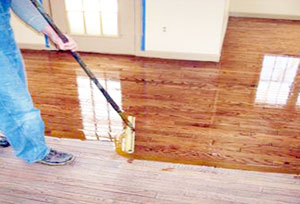 Water based polyurethane will greatly reduce the overall time to get your place back in order. Three coats can be applied & the floor can be walked on all in the same day (if floors are finished without staining). Plus the house can remain occupied. Furniture though should be carefully replaced not less than 3 days after the last coat is applied. So that’s a minimum of 4 days with water based polyurethane. Area rugs can be replaced 7 days after last coat is applied.
Water based polyurethane will greatly reduce the overall time to get your place back in order. Three coats can be applied & the floor can be walked on all in the same day (if floors are finished without staining). Plus the house can remain occupied. Furniture though should be carefully replaced not less than 3 days after the last coat is applied. So that’s a minimum of 4 days with water based polyurethane. Area rugs can be replaced 7 days after last coat is applied.
Oil based polyurethane needs 3 days to apply 3 coats, 1 more day to cure before walking on it with sox only, and at least 1 more day to cure before walking with shoes & carefully replacing furniture, though it’s better to wait 3 days. That’s a minimum of 5-7 days, but the house will have to be vacated for at least a few days to avoid the toxic fumes. For persons with breathing sensitivities it could take weeks for the air to clear. You’ll have to consider where to house family & pets.
Ideally it’s best to do a job using oil based polyurethane when away on vacation for a week or so, or before moving into a home. If your job involves large square footage, more prep work, dark stain, etc., it could require even up to 10 working days to complete which can mean 2 weeks. Pets should be kept off the floor for 2 weeks after the last topcoat application, unless they wear pet sox. Area rugs should be replaced after 30 days.
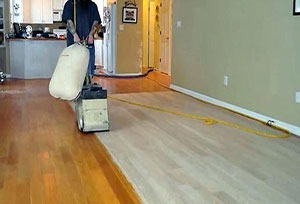 There are several factors in considering whether to use oil based or water based polyurethane. In New York City, apartment & condo buildings require water based finish due to the noxious fumes from oil based finish that can permeate a building for days. Homeowners have more of a choice between the two. Though more costly than oil based finish, water based finish is very popular nowadays. It has low fumes and dries quickly. Three coats of high quality professionally applied water based finish such as Bona Traffic will be equally as durable as three coats of oil based finish which can last 10 years. Low quality water based products though may only last 3-5 years. For a full comparison see water based vs oil based polyurethane floor finish.
There are several factors in considering whether to use oil based or water based polyurethane. In New York City, apartment & condo buildings require water based finish due to the noxious fumes from oil based finish that can permeate a building for days. Homeowners have more of a choice between the two. Though more costly than oil based finish, water based finish is very popular nowadays. It has low fumes and dries quickly. Three coats of high quality professionally applied water based finish such as Bona Traffic will be equally as durable as three coats of oil based finish which can last 10 years. Low quality water based products though may only last 3-5 years. For a full comparison see water based vs oil based polyurethane floor finish.
Should Wood Floors Be Refinished Before or After Painting ?
If you will also be painting walls then it’s important to consider in what order the work should be done along with floor refinishing. It is usually best to do prep work and paint the ceilings first. This avoids damaging newly finished floors with debris & latters. Painting walls after the floors are finished avoids worry about scuffing the walls during refinishing. Baseboards will need to be removed for refinishing. So they should also be painted after, along with any trim. This will also avoid leaving an unpainted gap on the floorboards. A gap could appear after the floors are sanded down if the floor boards are painted, removed for refinishing & then replaced. Be sure to dust surfaces to be painted as sanding will create dust. As mentioned, “dustless” vacuum equipped sanders will greatly reduce dust but some dusting will still be required.
Gemini Floor Services offers wood floor refinishing in Brooklyn, Long Island & New York city. Call now for a free estimate 718-690-3435
